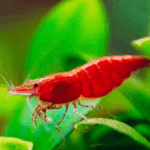Introduction to African Dwarf Frogs
If you’re looking for a small, peaceful, and unique aquatic companion, the African Dwarf Frogs might just be your perfect match. These charming little creatures are a type of fully aquatic frog, meaning they live their entire lives underwater—no dry land needed! Because of their manageable size, playful behavior, and minimal care requirements, they’ve quickly become a favorite small pet frog among aquarium hobbyists.
What makes the African Dwarf Frog especially appealing is how well they fit into a beginner’s freshwater setup. They’re curious, active, and surprisingly social, often swimming up to the glass or playing in their tank decor. Unlike many exotic pets, these frogs don’t require fancy equipment or complicated routines, making them a truly beginner-friendly pet.
Whether you’re setting up your first aquarium or adding a new personality to your tank, the African Dwarf Frog brings a touch of life and wonder to any underwater world.
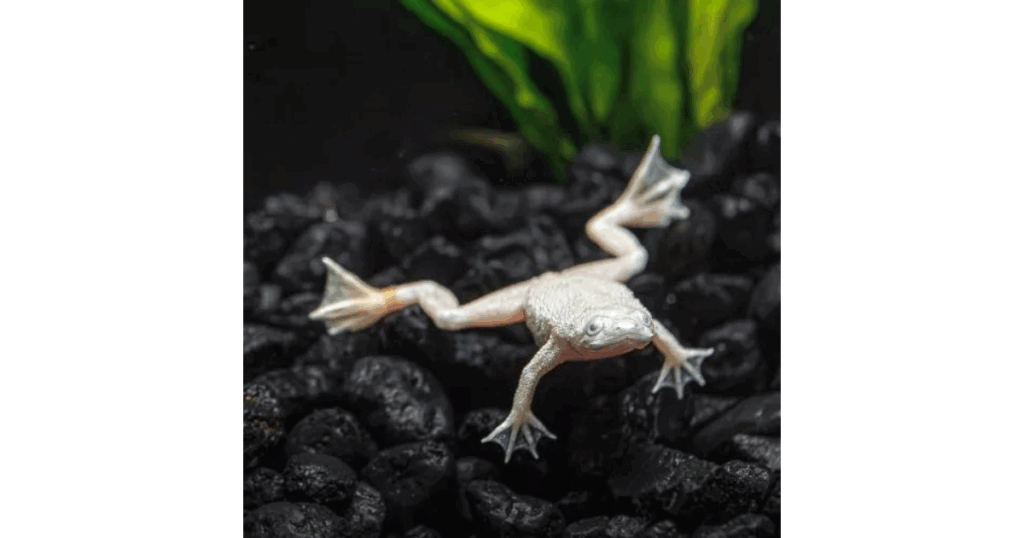
Understanding the African Dwarf Frog’s Natural Habitat and Behavior
To truly care for your African Dwarf Frog, it helps to understand where they come from and how they naturally behave. These fascinating little amphibians originate from the warm, shallow waters of Sub-Saharan Africa, where they thrive in slow-moving rivers, ponds, and streams. Their native aquatic frog habitat is filled with soft substrates, floating plants, and lots of hiding spots—conditions we can easily recreate in a home aquarium.
Behavior-wise, African Dwarf Frogs are peaceful, social, and surprisingly playful. They’re most active during the evening and nighttime hours, displaying natural nocturnal behavior. You might see them floating motionlessly at the top of the tank (a behavior called “burbling”) or hopping around in short, clumsy bursts from one corner to another.
Despite their small size, they’re full of personality. These frogs enjoy exploring their surroundings and will often interact with tank decor and tank mates, provided they’re not aggressive. They’re also bottom dwellers, meaning they’ll spend most of their time near the substrate, occasionally surfacing to gulp air—a normal trait for a fully aquatic frog.
By understanding the natural behavior of African Dwarf Frogs, you’ll be better equipped to create a comfortable, enriching environment that keeps them healthy and stress-free.
Tank Setup for African Dwarf Frogs
Creating the right environment is one of the most important steps in keeping your African Dwarf Frog happy and healthy. While they’re low-maintenance, they still require a properly equipped frog aquarium setup that mimics their natural habitat.
Let’s start with tank size. Although small, African Dwarf Frogs are active swimmers and should never be kept in tiny bowls. A 5-gallon tank is the bare minimum for one or two frogs, but a 10-gallon tank offers much more stability and comfort. If you plan to keep more, scale up accordingly.
Use fine gravel or sand as a substrate—avoid sharp or coarse gravel that could injure your frog’s sensitive skin. Decorate the tank with live or silk plants, caves, or smooth stones. They love places to explore and hide.
These frogs breathe air from the surface, so the tank should be shallow enough for easy access, and tightly covered—they’re excellent escape artists!
As for filtration, a gentle sponge filter is ideal. Strong currents stress them out. Keep lighting low to moderate; they don’t like overly bright environments.
Proper water parameters are crucial:
- Temperature: 72–78°F (use a heater if needed)
- pH: 6.5–7.5
- Ammonia/Nitrite: 0 ppm
- Nitrate: <20 ppm
Doing weekly water changes (25–30%) and regularly testing water quality will keep your African Dwarf Frog tank setup stable and clean.
In short, a well-thought-out aquatic frog tank goes a long way in promoting your frog’s well-being. It doesn’t take much, but it makes all the difference.
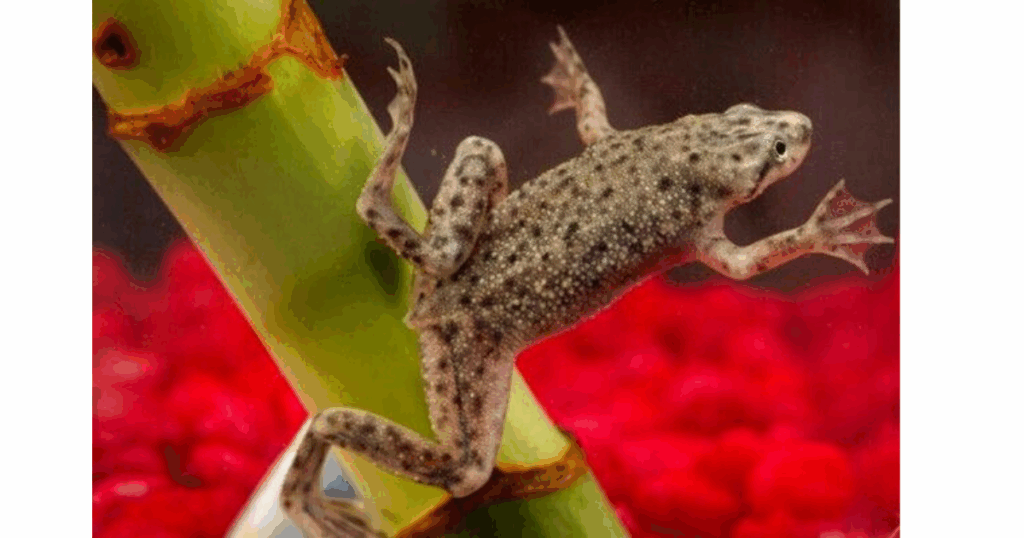
Feeding and Diet for African Dwarf Frogs
Feeding your African Dwarf Frog properly is essential to keeping them healthy and active. These little guys may be small, but they have big appetites—and specific preferences.
So, what do African Dwarf Frogs eat? In the wild, they’re opportunistic feeders, munching on small worms, insects, and crustaceans. In captivity, it’s important to mimic that diet with high-protein, carnivorous foods. Their favorites include:
- Frozen bloodworms (a top choice!)
- Brine shrimp
- Daphnia
- Sinking frog pellets (formulated specifically for aquatic frogs)
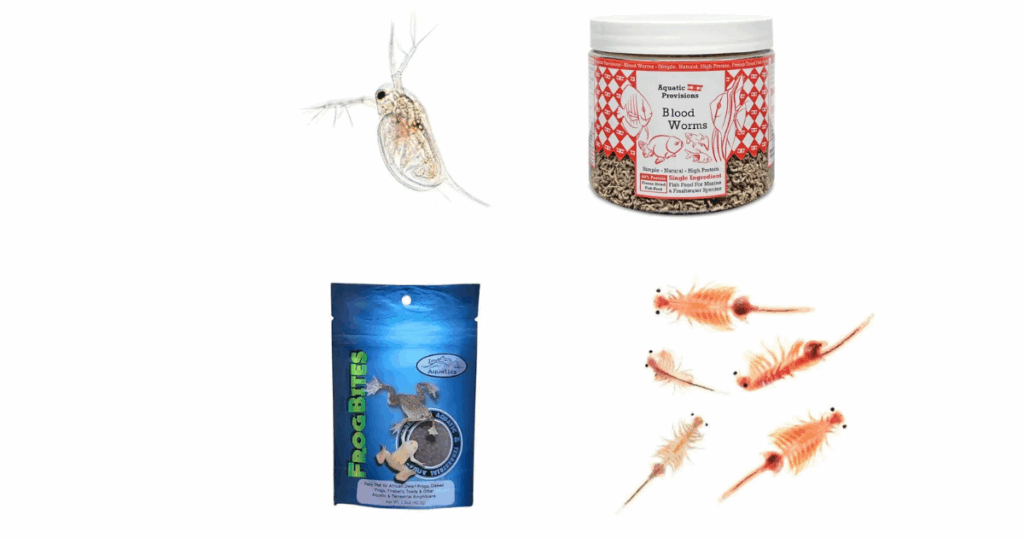
Avoid feeding them only flakes or floating pellets, as they often can’t find or catch floating food. They’re bottom feeders, so be sure their meals sink to the substrate.
Here’s a simple frog feeding guide:
Feed your African Dwarf Frogs once a day or every other day, depending on their age and appetite. Remove uneaten food within 15–20 minutes to maintain water quality. You’ll know they’re eating enough if they maintain a plump, healthy body—too thin, and they might need more attention.
Pro tip: Use tongs or a feeding dish to place food directly in front of them if you have fish or snails in the same tank. These frogs have poor eyesight and need a little help sometimes!
By sticking to a varied, protein-rich African Dwarf Frog diet, you’ll keep your aquatic pals well-fed, energized, and thriving.
Tank Mates and Compatibility
One of the best things about the African Dwarf Frog is how well it can get along with the right aquatic neighbors. These frogs are peaceful by nature and thrive in community tanks—if you choose the right tank mates.
When selecting African Dwarf Frog tank mates, look for peaceful aquatic pets that won’t nip fins, hog all the food, or bully the frogs. Good choices include:
- Neon Tetras
- Corydoras Catfish
- Guppies
- Harlequin Rasboras
- Mystery Snails
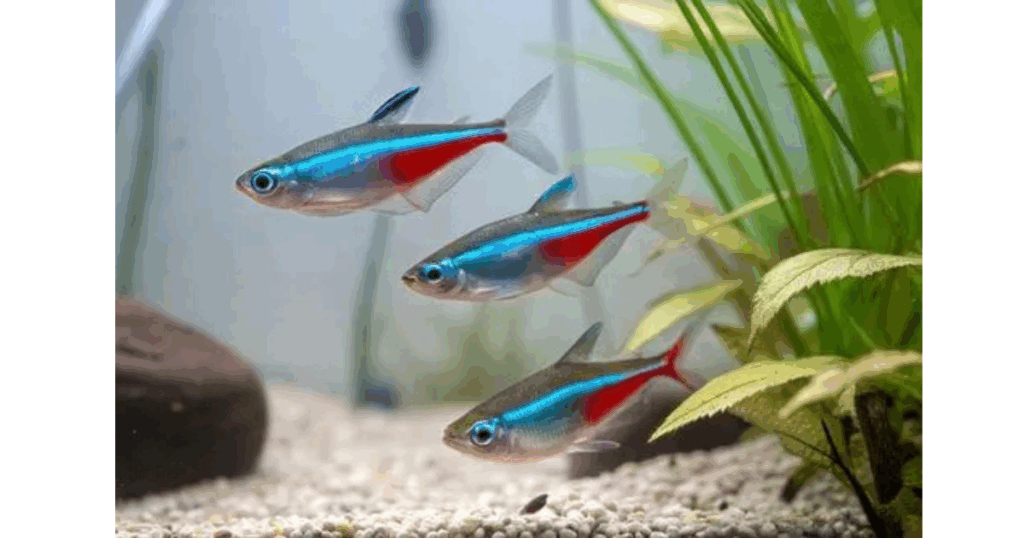
Avoid aggressive or fast-swimming fish like cichlids or barbs, as they can stress out your frogs. Likewise, large or overly active fish may outcompete them at feeding time.
It’s also important to remember that African Dwarf Frogs are not strong competitors for food. When housed with fish, be extra mindful during feeding to ensure the frogs get their share.
Never house them with African Clawed Frogs—they’re larger, more aggressive, and often mistaken for dwarf frogs in pet stores.
With the right frog-safe fish and a watchful eye, your African Dwarf Frog will enjoy a harmonious underwater life filled with friends—not foes.
Common Health Issues and How to Avoid Them
Even though African Dwarf Frogs are hardy little creatures, they’re not immune to health problems. Knowing the warning signs of illness and how to prevent them can help your frog live a long, happy life.
Here are a few common frog problems to watch for:
- Bloating or dropsy – swelling of the body due to fluid retention; often a sign of internal infection or organ failure
- Red leg syndrome – reddening of the limbs and belly, often caused by bacterial infection
- Fungal infections – white cottony patches on the skin, especially after an injury or poor water quality
- Lethargy or floating oddly – could indicate stress, illness, or poor water parameters
The good news? Most African Dwarf Frog health issues are preventable. Here’s how to avoid them:
- Keep water parameters stable and clean with regular water changes
- Avoid sudden temperature fluctuations
- Quarantine new frogs or fish before adding them to the tank
- Feed a balanced, protein-rich diet
- Avoid overcrowding the tank
If your frog shows any signs of illness, isolate them immediately and seek help from a vet who understands aquatic frog diseases. In many cases, early treatment can save your pet’s life.
Remember, prevention is always better than cure. A clean tank, good food, and a stress-free environment go a long way in keeping African Dwarf Frogs healthy.
Handling and Safety Tips
Unlike many terrestrial pets, the African Dwarf Frog should rarely if ever be handled. Their skin is extremely delicate and porous, which means it can absorb chemicals, oils, or bacteria from your hands in an instant. If you must move one for tank cleaning or a health check follow these safe frog handling basics:
- Clean, wet hands only
Rinse thoroughly with dechlorinated water (no soap) to avoid harming that sensitive skin. - Use a soft net or plastic cup
Gently guide the frog into a container filled with tank water; never chase or squeeze. - Keep time out of water short
Even a minute of exposure can stress an aquatic frog. - Wash up afterward
Protect yourself and the frog from cross-contamination.
Respecting these simple frog skin safety guidelines will keep both you and your African Dwarf Frog healthy, happy, and stress-free proving that good care sometimes means hands-off care.
Breeding African Dwarf Frogs
If you’re ready to take your African Dwarf Frog care to the next level, breeding them can be a rewarding (and adorable) experience. While not the easiest task, with the right setup and timing, it’s certainly possible—even for beginners.
Setting the Stage
To start breeding African Dwarf Frogs, you’ll need a dedicated breeding tank—ideally 10 gallons or more. Maintain warm water temperatures around 78–80°F, with plenty of live plants and hiding spots to mimic their natural breeding grounds.
Triggering mating behavior often involves simulating a “rainy season” by lowering the water level for a few days and then gradually raising it while increasing the temperature slightly.
Mating Behavior & Eggs
You’ll know aquatic frog mating has started when you see a male clasping a female in an embrace called amplexus. The female will lay hundreds of tiny eggs on surfaces like plants or glass.
After laying, it’s crucial to remove the adults—or they might snack on their own offspring.
Raising Tadpoles
Frog eggs hatch within 2–5 days. Feed the tiny tadpoles infusoria or liquid fry food, gradually moving to baby brine shrimp as they grow. Keeping water clean is essential for survival.
Keep in mind that not all eggs will survive, and raising froglets requires patience and precision.
With the right care and a bit of luck, you can witness the full life cycle of an African Dwarf Frog—a true joy for any aquatic pet lover.
Fun Facts & Why They Make Great Pets
The African Dwarf Frog isn’t just fascinating it’s also full of charm! These quirky little amphibians make an ideal beginner aquatic pet thanks to their easy care and unique personalities.
You can also check, Caring for African Dwarf Frogs by Aquarium Co op
Here are a few fun frog facts that make them stand out:
- They sing! Males produce a soft humming sound, especially during mating season.
- They breathe air. Even though they live underwater, they must surface to breathe through lungs.
- They’re social creatures. African Dwarf Frogs thrive in small groups just avoid overcrowding.
- They can live up to 5 years (sometimes longer) with proper care.
- They love to “float” at the surface this behavior is normal and often just means they’re relaxing.
What truly makes them great pets is their peaceful nature. They’re ideal for small aquariums, require minimal space, and have a calm temperament that suits both solo pet owners and families.
If you’re looking for a pet that’s low-maintenance but full of personality, an African Dwarf Frog might just be your perfect aquatic companion.
Frequently Asked Questions About African Dwarf Frogs
How big do African Dwarf Frogs get?
Adult African Dwarf Frogs usually grow to about 1.5 to 2.5 inches long. They’re small, fully aquatic, and remain tiny throughout their lives—perfect for nano tanks or desktop aquariums.
What’s the ideal tank size for African Dwarf Frogs?
While they don’t require a massive tank, aim for at least a 10-gallon aquarium for a pair or trio. This gives them plenty of room to swim and helps maintain stable water parameters—a key part of healthy aquatic frog care.
What should I feed my African Dwarf Frog?
These frogs are carnivores! Feed them bloodworms, brine shrimp, and sinking pellets specifically made for frogs or bottom dwellers. Use feeding tongs or place food near them so fish don’t snatch it all first. Feeding tips: 3–4 times a week in small portions.
Are African Dwarf Frogs active at night?
Yes, they are crepuscular, meaning they’re most active during dawn and dusk. You might notice more movement at night, especially when the lights go out—don’t worry, that’s normal frog behavior.
Can I hold my African Dwarf Frog?
It’s best not to. Their skin is highly sensitive and can absorb harmful substances from your hands. Unless necessary (like during tank cleaning), avoid direct contact.
Can African Dwarf Frogs live with fish
Absolutely—but only with peaceful, small fish like tetras or guppies. Avoid fin-nippers or aggressive species. Check out our guide on best tank mates for African Dwarf Frogs for more.
Check the links to buy
- Aquarium Filter: A small but powerful aquarium filter is a must. Look for one designed for small tanks (often labeled as a small aquarium filter) to keep your water clean and your fish healthy.
- Heater: If you’re keeping tropical fish, a fish tank heater is essential to maintain a stable water temperature around 75–78°F.
- Lighting: LED lights built into a tank hood are great for both aesthetics and plant growth.
- Thermometer: Helps you monitor the water temperature.
- Water Conditioner: Removes chlorine and harmful chemicals from tap water.
- Gravel/Substrate: Besides looking good, it’s necessary for beneficial bacteria.
- Test Kit: To monitor ammonia, nitrites, and nitrates—critical for tank cycling.


